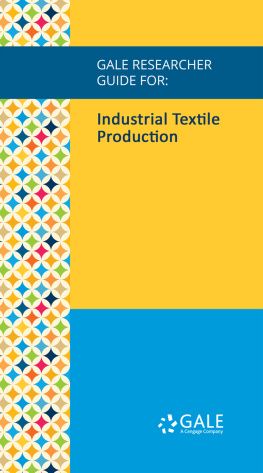TABLE OF CONTENTS
Guide
Gale Researcher Guide for: Industrial Textile Production
Content Strategist: Julie Carnagie Pitlock
Graphic Design Specialist: Kristine Julien
2018 Gale, a Cengage Company
ALL RIGHTS RESERVED. No part of this work covered by the copyright herein may be reproduced or distributed in any form or by any means, except as permitted by U.S. copyright law, without the prior written permission of the copyright owner.
For product information and technology assistance, contact us at Gale Customer Support, 1-800-877-4253.
For permission to use material from this text or product, submit all requests online at www.cengage.com/permissions.
Further permissions questions can be emailed to permissionrequest@cengage.com.
While every effort has been made to ensure the reliability of the information presented in this publication, Gale, a part of Cengage Learning, does not guarantee the accuracy of the data contained herein. Gale accepts no payment for listing; and inclusion in the publication of any organization, agency, institution, publication, service, or individual does not imply endorsement of the editors or publisher. Errors brought to the attention of the publisher and verified to the satisfaction of the publisher will be corrected in future editions.
Gale
27500 Drake Rd.
Farmington Hills, MI, 48331-3535
97-815-358-641-76 (Consumer)
97-815-358-641-69 (Library)
Gale Researcher Guide for: Industrial Textile Production
Gay L. Gullickson
University of Maryland
This article was originally published in Europe, 1450 to 1789: Encyclopedia of the Early Modern World, 2004. An abstract has been written, the bibliography has been updated, and the article has been edited for style by Aaron Irvin (Murray State University, History Department).
This article presents a brief overview of textile production, concentrating primarily on textile productions role in industrialization. Particular attention is paid to the emergence of new fabrics, styles, and techniques, as well as the increase in technology spurred by the growth of the textile industry. In addition, the social and cultural impact of textile industrialization is examined, with a particular focus on England as the earliest country to industrialize, as well as different cultures and nations and their reactions to the coming of industry.
Between 1450 and 1800, textile production was second only to agriculture in economic importance. It employed more people and produced more profit than any other manufactured product. Production and trade existed at two levels. Everywhere peasants and villagers turned locally grown wool and flax into fabric and clothing for themselves and their neighbors. The cloth they produced was of poor quality and not designed for export to distant markets. On top of this local market sat a large and lucrative luxury trade in silk, wool, linen, and (eventually) cotton fabric, the most important of which were heavy woolens. The customers for these fabrics were wealthy landowners, government and church officials, merchants, financiers, aristocrats, and master craftsmen in Europe, Asia, and the Levant.
Ireland and the Baltic region supplied much of Europes flax, although it was widely grown and available. In the sixteenth century Venice and other Italian cities acquired silkworms and mulberry trees and began silk manufacturing. From there, the silk industry made its way north to Holland, Zurich, Lyon, Cologne, and Spitalfields (East London), England. At the same time, cotton thread and fabric began to arrive from India and became wildly popular.
Most important of all the textile industries was the trade in raw wool and wool fabric. Sheep raising abounded everywhere. In the fifteenth century the best fleeces came from England. In the sixteenth century Spanish merino sheep knocked English sheep into second place. French sheep were considered to produce the third-best wool. Two types of wool fabric were produced in Europe: woolens and worsteds. Of the two, the market for woolens was by far the larger. Woolens were made from short-staple wool fibers that were swirled together before spinning. The cloth had a soft-textured appearance and feel. Worsteds were made from long-staple wool and had a harder, smoother finish. Soft woolens were considered far more desirable than the harsher worsteds and dominated the wool trade.
Producing Fabric from Wool
Turning raw wool into fabric was a long, complicated process. The sheeps fleece was sheared in one continuous piece, rolled, sacked, and sold to merchants (drapers) or clothiers or their agents. The fleeces were dirty and greasy, not uniform, and far from ready for spinning and weaving. Fleece breakers opened up the fleece and removed the large pieces of debris that were caught in it. The fleece was then pulled apart, and the wool was sorted into three or four grades. Next, the sorted wool was cleaned. Any remaining debris was removed from the fleece by beating it with sticks, and then it was washed in alternating hot and cold, soapy and clean water. Some fleeces were dyed at this point, but dyeing raw wool produced dull colors, and it was common to dye fabric after it was completed rather than when the wool was raw. Whether it was dyed or not, the fleece was now lubricated with butter or oil to make it easier to work.
After breaking, cleaning, and oiling, the wool passed into the hands of combers and carders. Their task was to convert a mass of tangled, curling wool into long, straight, smooth fibers for worsteds by combing, or into a smooth ball of short wool fibers for woolens by carding. Spinners converted the combed or carded wool into continuous lengths of yarn by pulling, twisting, and turning it into a thin, continuous thread. This was the most labor-intensive part of the process. Estimates vary, but six spinners (or more) seem to have been required for every loom that was in operation. Yarn that was spun with a drop spindle was stronger than wheel-spun yarn and was used for the looms warps. Wheel-spun yarn was wound onto bobbins and used for the weft.
Weavers usually wound their own warps and prepared their own bobbins for the loom. The best woolens were woven on broadlooms that produced fabric that was 4 feet (1.25 m) wide and about 72 to 75 feet (2223 m) long. It commonly took two men and one child (most often, probably, a boy in training) to operate a loom and weave the cloth. Once the woolen cloth was woven, it passed into the hands of fullers who cleaned and softened it by dunking it in water that contained various kinds of detergents and soaps that dissolved or absorbed the fat that had been added to the wool before it was carded or combed. Lye, stale human urine, ashes, and fullers earth were commonly used. Fullers placed the folded cloth in a vat and trod on it with their feet, periodically removing and refolding the cloth so it would be evenly fulled.
After fulling, the cloth was dried, stretched, bleached, and perhaps dyed. Teaselers raised the nap by brushing the cloth with the burr of the teasel plant to impart a soft finish. It was clipped smooth by shearmen, pressed, and returned to the merchant for sale. The entire process involved twenty people (not including dyers) for each piece of cloth produced and took at least six weeks. Women worked as carders, combers, and spinners, while men performed most of the other tasks. The finer the cloth, the larger the labor force and the longer the time it took to produce it. (More finely spun yarn required more spinners, for instance). The finishing of worsteds was much simpler (they did not require fulling, teaseling, or shearing, for instance), but the market for them was much smaller.















